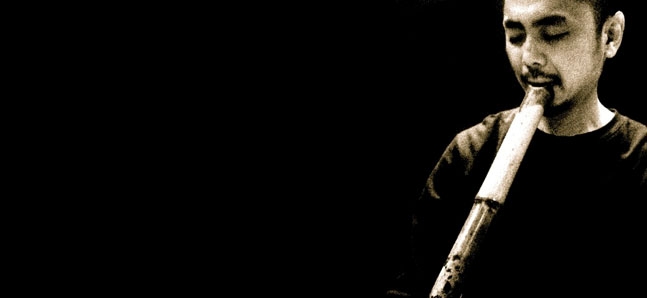
Posted: Wed Nov 23 2011
One-time hardcore kid Kenji Ikegami found his true calling when he bought a shakuhachi in a junk shop at the age of 22. He talks to Time Out about the history of the instrument, and how he found a unique place for it in Tokyo's club scene.
How old were you when you started playing shakuhachi?
I was about 22, so it'd be seven, eight years ago now. When I was a teenager, I listened to stuff like Bob Marley and Jimi Hendrix, but when I got to high school I started listening to dub and club music. I was messing around in a punk/hardcore band, too, playing covers of Japanese hardcore. It was basically just an excuse to be violent. (Laughs)
Where do you come from originally?
From Kumamoto. I wanted to work in a used record shop, so I moved to Fukuoka when I was 18. I tried buying a sitar and tabla when I was living there, but I didn't have anyone to teach me so eventually I gave up. I started DJing when I was in my second year at high school, and that became my main focus.
So how did you end up playing shakuhachi?
I was digging deeper into the stuff I liked, and that's what I unearthed. I was born and grew up in the countryside, so I was familiar with kagura [traditional Shinto theatrical dance]. When winter came, you'd hear Japanese flutes and taiko… but I never even touched a shakuhachi until I was grown up. In my head, the music I played when I was DJing and the shakuhachi had something in common. I was drawn to the sound of the flute in the past – there are odd-sounding flutes in free jazz, right?
Like Pharoah Sanders' records from the '70s...
Exactly. That's when I got interested in Asian flutes. Around the time that I bought a sitar and tabla, I started to take a general interest in Asia.
And you started playing shakuhachi when you were 22. Where do you actually buy one?
I didn't have any idea myself, so I bought my first shakuhachi from a junk shop. The thing is, I couldn't get any sound out of it – I had no idea how you were supposed to play it. After that, I went to a well-known shakuhachi shop called Mejiro. They sell komuso goods and everything. (Laughs) My current teacher happened to be giving a lecture there at the time, and that's what got me started with the shakuhachi.
[Note: Komuso were itinerant monks from the now-defunct Fuke Buddhist sect, easily recognised by the straw baskets worn on their heads, who practised meditation and raised alms through playing the shakuhachi.]
What's your teacher's name?
His name is Keisuke Zenyoji. If I hadn't met him, I probably would've given up on the shakuhachi.
Was that when you became interested in the world of komuso?
No, I'd read up about it before then. I'd even thought about becoming a monk myself at one point, but I thought I should experience the world, too – I wanted to experience both. When I started reading about komuso and heard about the concept of hanso-hanzoku, it was like a lightbulb went off in my head.
What's hanso-hanzoku?
Simply put, it means you're half monk, half layman. It's like existing in the space between the sacred and the worldly. Komuso didn't shave their heads, and they didn't have an established routine. They would stand in front of a house and play a song for Buddha, and then they'd live off the alms they were given. A lot of them were former samurai: I heard from my teacher that there were cases of samurai becoming komuso in order to get by after all the work dried up.
What's interesting about the shakuhachi music that komuso played is that it expresses nature and living things – you can see hints of an animist kind of thinking.
There's an important shakuhachi piece called 'Kyorei', which imitates the sound of bells that Fuke Buddhists rang in the streets. 'Taki Ochi' represents the rain that falls in the mountains transforming, drop by drop, into a river. 'Tsuru no Sugmori' depicts a crane nesting, and then flapping its wings. There are lots of examples like this, of pieces which take their inspiration from nature.
'Kyorei' was written 700 years ago, which is pretty amazing when you think about it. It must be a strong melody, to have survived since then...
I told my teacher that I wanted to write one song that endured as one of the old classics, and he laughed a little and said, 'Not on your life.' (Laughs) Even if you play shakuhachi for decades, compared to 700 years ago it's an instant. When you play a 700-year-old song, you can feel the spirituality and views about life and death that people had then. It feels like deciphering an old book: you can accumulate wisdom beyond what you'd get in your own lifetime. You begin to understand this a little as you learn to play.
Komuso monks belonged to the Fuke school. Did that come from China?
Yes, that's right. The shakuhachi itself is originally based on a Chinese flute called the dongxiao. In the Middle East, they had the ney, and in Japan it became the shakuhachi... Wherever you are in the world, I don't think there's that much difference in the act of performing music. Whether it's Africa or the Middle East, I'll often listen to music from other areas and think, 'We're expressing the same things.' The scales and rhythms might be different, but I think the root is the same.
With your album, Silence Mind, there's a really strong sense that the person who made it came through the club music scene – you hear it in the low-end, for instance.
The whole appeal of club music is something you feel with your body, and I was definitely aware of that. When I play the shakuhachi, I'm not thinking in my head, I'm feeling with my entire body. I wondered if that was something I could express over the speakers.
When did you start to mix shakuhachi with electronics?
When I first started playing shakuhachi, I was going through a rough period in my own life. The shakuhachi really clicked with me then. I thought I'd sell off everything I had, and I sold all my musical gear and records. I really felt like I'd start again with nothing but that single shakuhachi. I met my teacher, stopped DJing, and was spending my life practising zazen at a temple in Shinjuku called Hosshinji. When I adopted an electric style, I was just fooling around at first: I was at a friend's house, and I thought I'd give it a go. I think the qualities of synthesizers and shakuhachi are polar opposites, and I feel the appeal of the shakuhachi lies in the subtle expressiveness of the sound. But at the same time, I grew up in the clubs, and that's also a part of me, so I was drawn to both the shakuhachi and electronic sounds. I thought that if you played both together, they'd both shine.
But the tone of the shakuhachi isn't something that you can easily replace with Western chords, is it?
The shakuhachi has a key, too, so the synth backing track plays as a drone in that key. If there's too much overlap between the drone and the melody, it clashes with the sound of the shakuhachi, so I kind of leave some space there. I've been interested in drones for a long time – they're very easy to meditate to. You could say they boost your concentration. But silence is key with the shakuhachi, so maybe it's a taboo.
What does your teacher think of the music you're making?
It's nothing like the music he's been listening to before… he was kind of like, 'That's not bad, is it?' (Laughs) When I released the album, he acted like, 'Hey, it can't be helped if you get excommunicated.' But this is my own way of expressing myself, so I don't feel guilty about it – I think I should do it the way I want to. In the later days of the komuso, the musical side got stronger. I think that if they'd had synthesizers back then, some people would've said, 'You know, these are better than koto.' (Laughs)
I see. (Laughs)
When I saw my teacher perform, what struck me the most was that he was expressing the entire universe with a single piece of bamboo. In three songs, he painted the cycle of the universe. I thought: I want to do that too.
Kenji Ikegami plays at Movements, Eleven, Nov 26
Tweets
- About Us |
- Work for Time Out |
- Send us info |
- Advertising |
- Mobile edition |
- Terms & Conditions |
- Privacy policy |
- Contact Us
Copyright © 2014 Time Out Tokyo














Add your comment